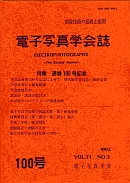Volume 32, Issue 1
Displaying 1-7 of 7 articles from this issue
- |<
- <
- 1
- >
- >|
-
1993Volume 32Issue 1 Pages 3-6
Published: 1993
Released on J-STAGE: May 31, 2007
Download PDF (451K) -
1993Volume 32Issue 1 Pages 7-12
Published: 1993
Released on J-STAGE: May 31, 2007
Download PDF (829K) -
1993Volume 32Issue 1 Pages 13-17
Published: 1993
Released on J-STAGE: May 31, 2007
Download PDF (587K) -
1993Volume 32Issue 1 Pages 18-23
Published: 1993
Released on J-STAGE: May 31, 2007
Download PDF (607K) -
1993Volume 32Issue 1 Pages 25-29
Published: 1993
Released on J-STAGE: May 31, 2007
Download PDF (903K) -
1993Volume 32Issue 1 Pages 30-34
Published: 1993
Released on J-STAGE: May 31, 2007
Download PDF (736K) -
1993Volume 32Issue 1 Pages 35-42
Published: 1993
Released on J-STAGE: May 31, 2007
Download PDF (1577K)
- |<
- <
- 1
- >
- >|
